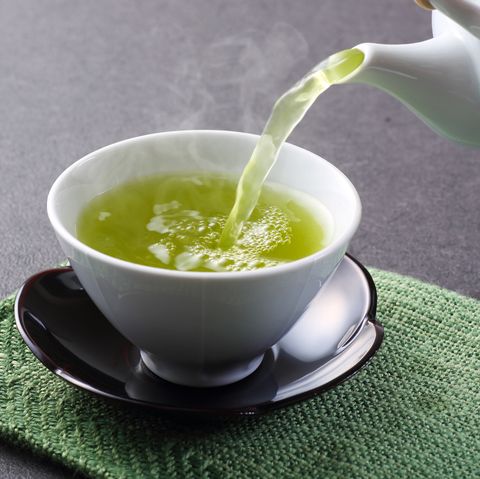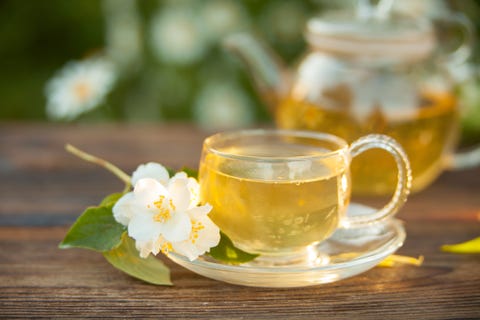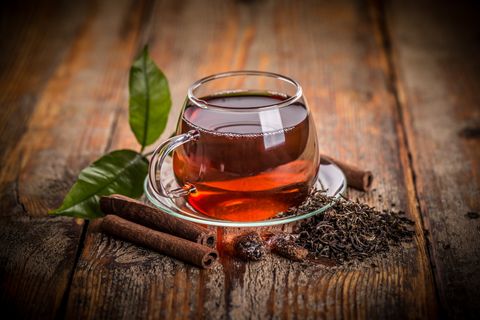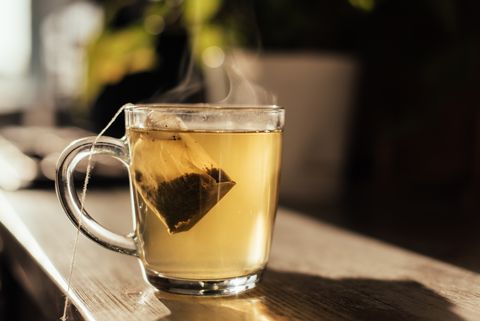When the weather outside is cold and gray the there’s hardly anything more comforting than a warm cup of tea. Whether you like to cozy up with the robust, citrusy tones of an Earl Grey, the sweet, floral aroma of jasmine tea or whatever your favorite brew is there’s just something about sipping tea that feeds the soul. (Unless you’re more of a coffee or cocoa person.)
While some of us find tea soothingly tasty, you may just drink tea simply for your own well-being. Many types of teas have been hyped up for specific health-boosting properties like: some supposedly speed up weight loss or help to prevent heart disease, while others decrease blood pressure. That’s why there are tea advocates that suggest incorporating certain teas into your diet to meet your health goals.
But, what exactly makes each tea so unique and how many of these health claims are actually true? To answer these questions, we’ve talked to experts and dug into the research to find out.
What is tea made of?
Despite all of the varieties of tea you might see at your local cafe, all “true” teas — meaning the ones that aren’t considered “herbal” like chamomile or hibiscus — are derived from the same shrub that’s grown all over the world: the camellia sinensis plant a.k.a. the tea camellia tree.
So, “there isn’t a white tea plant or a green tea plant,” says Lisa Boalt Richardson, the director of World Tea Academy and the author of Modern Tea: A Fresh Look at an Ancient Beverage. Instead, what gives each type of true tea their distinct color and flavor is the manufacturing process, which includes:
- The time the leaves are harvested
- How long and in what way they were allowed to wither
- How long the leaves were oxidized or browned
Each part of the process not only influences the look and taste of the tea, they illicit certain chemical reactions that change the micronutrients within the leaves, according to Richardson.
What are the health benefits of tea?
Just to be clear: “Tea is food, not medicine,” says Richardson. In other words, it has not been proven that tea can cure or heal any disease or ailment. Nor is there any solid evidence of tea being able to speed up your weight loss journey, she adds. So don’t bother shelling any cash on those so-called “fat-busting” detox teas.
But, tea does contain nutrients that researchers say may support a healthy diet. For example, tea contains:
- Polyphenols. These act as anti-oxidants that help to fight the free radicals that damage your cells, according to Harvard experts. This may be why some research suggests that drinking two to three cups of polyphenol-rich tea daily has the potential (keyword: potential) to reduce the risk of premature death, heart disease, stroke and type 2 diabetes as well as to help to lower blood pressure. But there are plenty of studies that show conflicting results. One of the reasons for this could be because polyphenol content highly varies among tea types and brands; it also changes according to where the tea was harvested, how the plant was grown, and how it was processed. Not to mention, if you like your milk teas and lattes, the health benefit that you’re going for may be affected. Studies have found that adding milk, honey and lemon can interfere with how polyphenols interact with your body.
- Methylxanthine. Most of us are familiar with the most talked about methylxanthine: caffeine. It can help us get that needed energy boost when we are feeling sluggish or foggy. But in the case that caffeinated drinks like coffee make you feel too jittery, tea may offer you a gentler experience since it tends to have less caffeine. According to experts from the Mayo Clinic, one cup of brewed coffee has 96mg of caffeine while one cup of plain black tea has about 47mg. Tea also contains two other types of methylxanthines, theophylline and theobromine, which, while stimulating are both considered muscle relaxants, according to Richardson. This counteracts the jitteriness you might feel by just having caffeine.
- L-theanine. This amino acid is the other reason why tea doesn’t make you as wired as coffee, according to Richardson. “It keeps you alert, but it is also very soothing,” she says. Some scientists believe this is because L-theanine has the ability to pass through the blood-brain barrier and increase the alpha brain waves which are associated with mental states of alert relaxation like when you’re daydreaming or meditating.
Again, drinking a lot of tea probably isn’t going to lead to health miracles, but Richardson finds that the greatest benefit of drinking hot tea is how it encourages you to slow down during the day and practice mindfulness.
“Just sitting quietly, drinking a cup of tea will give you that mind-body-soul connection,” she says. “Stepping aside and giving yourself ten minutes in the middle of the day can rejuvenate your mind.”
Types of healthy “true” tea
All teas are “healthy” teas, says Richardson — there’s no type that’s better than the other. But, to give you an idea of how they differ, here are the six types of true teas and what makes them taste and look so unique:
Green Tea
Green tea leaves are picked from the camellia sinensis plant then are sometimes withered a bit but are always cooked (either pan-fired or steamed) to prevent as much oxidization as possible, says Richardson. Stopping the oxidation process in its tracks helps to preserve their rich green color and the grassier taste. Because the green tea leaves aren’t as processed as other darker teas, they tend to have higher levels of catechin, one of those polyphenols that fights off those pesky free radicals.
Flavor: grassy, vegetal, herbaceous
Examples of green tea: Jasmine, Matcha, Genmaicha, Hojicha
White Tea
To make white tea, harvesters need to snatch the leaves when they are very young (even younger than green leaf harvests). When the leaves are merely buds, they are usually covered in “white downy fuzz”, according to Richardson, which is where the “white” name comes from. Once they are plucked they are dried to minimize oxidation. Like green tea, the white variety tends to have higher levels of catechin since it is the least processed, according to researchers.
Flavor: subtlety sweet, fruity, floral, mildly grassy
Examples of white tea: White Peony, Silver Needle, Shou Mei
Black Tea
What makes black tea black is the oxidation process. When the leaves are rolled then exposed to oxygen-rich air, they begin to produce theaflavin and thearubigin — antioxidant polyphenols that give the leaves their dark red/brown pigment. Eventually, they appear black. Oxidation is also what helps to give black tea its bold flavor profile.
Flavor: sharp, bitter, full-bodied, malty, floral
Examples of black tea: Earl Grey, Assam, English Breakfast, Darjeeling
Yellow Tea
This may be one of the least known teas in the West since “it is difficult to source because the harvest time is short, the processing is complex and time-consuming, and, until recently, China was the only producer,” Richardson writes in her book Modern Tea. Yellow tea is made with leaf buds plucked in early spring. They are then processed like green teas through pan-firing or treated with a gentle heating method called men huan (sealing yellow). Next they are wrapped in paper or a dampened cloth and left to cool before potentially being pan-fired again. How many times they are pan-fired and how long they are wrapped depends on the tea maker, but this process can last three to four days, says Richardson.
Flavor: sweet honeysuckle and apple notes
Examples of yellow tea: Gentleman Mountain Silver Needles, Mengding Yellow Sprout, Huo Mountain Yellow Sprout
Oolong Tea
Oolong tea leaves are partially oxidized so many of them don’t quite reach that dark, full-bodied taste of black teas, but this brew has its own kind of yummy. The taste of oolong varies greatly depending on how long the tea maker decides to oxidize the leaves. “The levels of oxidation can range anywhere from as little as 10 percent, making it similar in appearance to green tea, to as much as 80 percent, resulting in what looks like black tea,” writes Richardson.
Flavor: toasty, slightly sweet, potentially grassy, sometimes floral or fruity
Examples of oolong tea: Baozhong, Tung Ting, Tie Guanyin, Da Hong Pao, Bai Hao
Dark tea (Pu’erh)
Pu’erh — which originated in Yunnan Province in China and now is popularly called “dark tea” in the West — goes through an extra step that other teas skip: a fermentation process that is often kept secret by tea makers, says Richardson. Though our lips are sealed regarding the details (really, we couldn’t tell you if we wanted to), in general, “fermentation is the chemical breakdown of a substance by bacteria, yeasts, or other microorganisms, typically involving effervescence and the giving off of heat,” says Richardson. Next the leaves are aged for a while — sometimes for years, according to experts from Reishi Tea and Botanicals. This all gives dark tea its uniquely robust flavor.
Flavor: earthy, smooth, woodsy, slightly sweet
Examples of dark tea: Shen Pu’erh, Shou Pu’erh
Choose your brew
In short, if you ever get curious, there’s a whole world of tea to explore. Each brand and each variety have their own distinct flavor profiles — and some would suggest that they also have their own unique health benefits, but remember: there’s not enough research to declare that any tea will have a significant impact on anyone’s physical health. But routinely taking some time to sit, breathe and sip on your favorite brew may do wonders for your mental well-being in the long run.
This content is created and maintained by a third party, and imported onto this page to help users provide their email addresses. You may be able to find more information about this and similar content at piano.io






